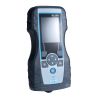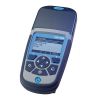Hach SL1000 Portable Parallel Analyzers
Features
- Test up to six parameters, in parallel 75% faster
- Utilizes Chemkey reagents instead of powder pillows
- Automation and internal temperature control
- Free ground shipping
- Expedited repair and warranty service
- Lifetime technical support
- More
Overview
The Hach SL1000 Portable Parallel Analyzer (PPA) is a portable colorimeter that performs the same tests with less than half the manual steps of typical colorimeters. Combining both probe-based testing and colorimetric analysis into a single instrument with highly-accurate results makes the SL1000 a great tool for both the lab and field.
Multiple Parameter Testing
Up to six parameters, tested in parallel. The SL1000 provides 75% faster testing in chloramination applications by using Chemkey reagents instead of powder pillows. All chemicals and processes are entirely contained inside the Chemkey (see the accessories tab for reagent options). Probe-based tests include: pH, conductivity, ORP, dissolved oxygen, nitrate, and fluoride (temperature is included with each probe).
*Kit contents are listed in the specifications tab
SL1000 Portable Parallel Analyzer (PPA) – Basic Instrument Package
- SL1000 meter
- Carrying case
- 1 instrument sample cup
- 2 probe sample cups
- Rechargeable battery
- Battery charger
- Hand strap
- Instrument manual
- USB cable
SL1000 Portable Parallel Analyzer (PPA) - Kit
- Basic instrument package
- 1 pH probe
- 1 conductivity probe
- 1 box each of Free Cl, Total Cl, Monochloramine, Nitrite and Free Ammonia Chemkeys
SL1000 Portable Parallel Analyzer (PPA) - Nitrification Kit
- Basic instrument package
- 1 pH probe
- 1 nitrate probe
- 1 box each of Free Cl, Total Cl, MonoCl, Free Ammonia and Nitrite Chemkeys
SL1000 PPA Analyzer Specifications
|
Battery Life: |
>200 Chemkey tests per full battery charge |
|
Battery Requirements: |
Rechargeable Lithium-Ion battery pack |
|
Certifications: |
CE Compliant |
|
Detector: |
Silicon photodiode |
|
Enclosure Rating: |
IP64 |
|
Includes: |
SL1000 meter, carrying case, 1 instrument sample cup, 2 probe sample cups, rechargeable battery, battery charger, hand strap, instrument manual, and USB cable. |
|
Instrument Bundle: |
SL1000 Portable Parallel Analyzer (PPA) Portable Colorimeter with USB |
|
Interfaces: |
Mini USB |
|
Kit Option: |
Instrument Only |
|
Lamp Type: |
Light Emitting Diode (LED) |
|
Measurement Modes: |
Transmittance (%), Absorbance (abs) and Concentration (Conc) |
|
Operating Temperature Range: |
5 - 50 °C / maximum 85% relative humidity (non-condensing) |
|
Protection Class: |
III |
|
Storage Conditions: |
-20 - 60 °C / maximum 85% relative humidity (non-condensing) |
|
Warranty: |
12 months |
|
Weight: |
2.65 lbs. (1.2 kg) |
In The News
Sargassum Surge: How Seaweed is Transforming our Oceans and Coastal Ecosystems
Until recently, Sargassum –a free-floating seaweed–was distributed throughout the Sargasso Sea , the north Caribbean Sea, and the Gulf of Mexico. But in the space of a decade, this seaweed has, as one scientist remarks , “Gone from a nonfactor to the source of a terrible crisis.” Driven by climate change, anomalous North Atlantic Oscillation in 2009-2010 and a glut of anthropogenic pollutants, sargassum has proliferated. Seasonally recurrent mats as deep as 7m now bloom in the “Great Atlantic Sargassum Belt” (GASB), which covers areas of the Atlantic from West Africa to the Caribbean Sea and Gulf of Mexico. Every year, millions of tons wash up along the shores of more than 30 countries . Dr.
Read MoreGreat Lakes Research Center: Designing Targeted Monitoring Solutions
According to the National Oceanic and Atmospheric Administration ( NOAA ), the Great Lakes have more miles of coastline than the contiguous Atlantic and Pacific coasts combined and contain 20 percent of the world's freshwater, making it a critical region to protect and conserve. Continuous monitoring and data-informed resource management are key components of managing waters in the region. Hayden Henderson, a research engineer with the Great Lakes Research Center (GLRC), designs and deploys monitoring platforms throughout the Great Lakes. With a background in environmental engineering, Henderson enjoyed the challenge of creating systems and making them work to obtain difficult, remote measurements.
Read MoreMonitoring Meadowbrook Creek: Real-Time Data Collection in an Urban Creek
Meadowbrook Creek in Syracuse, New York, has been monitored by Syracuse University (SU) faculty and students for over a decade. Originally established by Dr. Laura Lautz in 2012, the early years of the program focused on collecting grab water samples for laboratory analysis and evaluating the impact of urban land use, human activities, and natural processes on water resources. Tao Wen , an Assistant Professor in SU’s Department of Earth and Environmental Sciences, took over the program in 2020 and upgraded the existing systems to include 4G modems that allowed for real-time data viewing. [caption id="attachment_39339" align="alignnone" width="940"] An overview of the Fellows Ave monitoring station along Meadowbrook Creek.
Read More











































